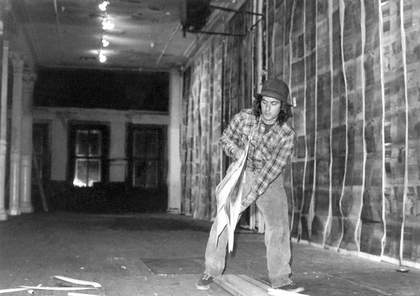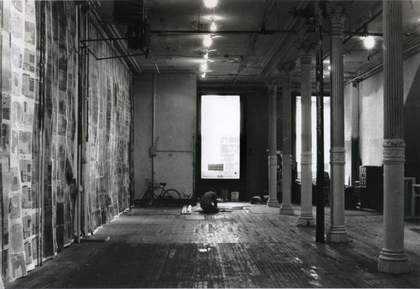Gordon Matta-Clark was part of a loose but close-knit coalition of artists and dancers whose work and lives coalesced around the large lofts left over from an earlier industrial age in New York’s Soho.1 When Jeffrey Lew, a friend of Matta-Clark, opened up 112 Greene Street in October 1970, it immediately became what would now be called an alternative artist-run exhibition space. Before that 112 Greene Street was simply a place where artists could display their works for an audience of friends, and it was in this crumbling space that Matta-Clark installed his work Walls Paper 1972 (Tate T14658; fig.1).

Fig.1
Cosmos Andrew Sarchiapone
Gordon Matta-Clark installing Walls Paper at 112 Greene Street in 1972
Cosmos Andrew Sarchiapone papers, circa 1860–2011, bulk 1940–2011, Archives of American Art, Smithsonian Institution, Washington, D.C.
Greene Street, and Soho more generally, were vital in Matta-Clark’s thinking about buildings and space. As young children he and his twin brother Sebastian (Batan) lived with their mother Anne Clark in an apartment on LaGuardia Place, less than half a mile from 112 Greene Street. Later the family decamped to the West Village as a consequence of the growing real estate interest in Soho (Bruce Jenkins particularly cites New York University’s expansion plans).2 Thus at an early age Matta-Clark experienced the redevelopment of the city as a specific imposition on his living situation. The shifting urban and domestic situations were one and the same.
Matta-Clark recalled how important the living/working conditions of Soho were for his artistic development: ‘One of the things that’s clearest in my mind is how [my] interest in working with buildings originated. It evolved out of that period in 1970 when I was living in the basement of 112 Greene Street and doing things in different corners. Initially they weren’t at all related to the structure. I was just working within a place, but eventually, I started treating the place as a whole, as an object.’3 It is telling that Matta-Clark does not credit his interest in structures to his training as an architect. Indeed, he deliberately circumvented that narrative when, in an interview with critic Donald Wall, he traced his genealogy ‘not to the Bauhaus, not to Corbusier, but to 112 Greene St’.4 In side-stepping the achievements of modern architecture – achievements with which he would have been familiar from his studies at Cornell University, as well as, more intimately, through conversations with his father – Matta-Clark offered an alternative and much broader idea of what architecture and community could mean.5
From dilapidation to creation
112 Greene Street may have inspired interest in such structures for Matta-Clark in part because its structure was so compromised. As Robyn Brentano, the first author to write a history of the space, noted: ‘In 1970, the walls were crumbling, there was no heat, and the place was dimly lit’.6 Jane Crawford, Matta-Clark’s widow, offered a similarly frank assessment: ‘The space was a dilapidated mess’.7 In being so far from the immaculate utilitarian buildings that architects are so often called upon to produce, the building at 112 Greene Street was a space that Matta-Clark could incorporate ready-made into his work. It was his laboratory and his medium. In her Artforum review of Matta-Clark’s 1972 show that featured Walls Paper, critic April Kingsley wrote: ‘A section of wall, a hunk of floor or ceiling (depending on how you look at it) becomes a work of art when it is transferred to the setting of a gallery. 112 Greene Street, however, looks like the sites from which his pieces have been removed, which makes it difficult for the viewer to “see” his work as art … Matta-Clark has left himself only a very fine margin between art and life in which to manoeuvre.’8 As Kingsley realised, 112 Greene Street was a space which prescribed that differentiating between art and debris was the critic’s first task.9
It is clear, then, that 112 Greene Street was hardly a ‘non-site’, to use Robert Smithson’s nomenclature.10 While artists like Smithson were critiquing the deceptively neutral stance of the white-walled gallery by designating such places non-sites, Matta-Clark initially worked with the exhibition space as a specific site itself.11 Artist Tina Girouard later called 112 Greene Street ‘an arena’, saying ‘we preferred to make our own arena, not the museums or the galleries’.12 For a time it was able to operate outside of the constraints of art’s more traditional institutions, and several artists who exhibited at 112 Greene Street recalled how it was unlike other gallery spaces – not at all commercial, decidedly bohemian, unapologetically raw. Rachel Wood, Lew’s wife, recalls how run down 112 Greene Street appeared when it was initially offered for sale. A former rag-picking building, it was ‘completely full of bales of old rags … We moved in and I was living on the sixth floor with these old disgusting toilets and mice running everywhere … It was rough. It was definitely rough.’13 In Wood’s account, she supplied the money for the purchase of the building, while Lew raised funds for the gallery space, cultivating connections with friends and potential philanthropists, but mostly giving the impression that the exhibition site was a space for the spontaneous expression of creative energy. Many of the artists involved in Greene Street have echoed this sentiment: ‘112 was something that was just there’;14 ‘It happened automatically’;15 and ‘112 was by accident’.16 In this sense, the ‘as-is’ spirit of 112 Greene Street enhanced the stumbled-upon quality of Matta-Clark’s work. Jeffrey Lew succeeded in taking a forgotten space and turning it into something with significance.
Lew and Wood’s choice to purchase the building at 112 Greene Street outright is also a factor to consider – it mattered that this was not a rented property, that there was a sense of communal responsibility towards it when Lew offered it to artists as a space to exhibit, display, discuss and generally hang around. Artist and dancer Carol Goodden recalls that ‘112 became a big thing, there was nothing like it anywhere else. At 112 anything they wanted was allowed to happen. It was complete freedom.’17 In particular, the space perhaps offered freedom from participation in a system that mainly rewarded commercially viable production – creative or otherwise.
An experimental space
As his laboratory, 112 Greene Street was a site of investigation for Matta-Clark, and Walls Paper was arguably one of the means by which he did so. The artist has stated: ‘I wanted to alter the whole space to its very roots, which meant a recognition of the building’s total (semiotic) system, not in any idealised form, but using the actual ingredients of a place’.18 Matta-Clark refused to consider buildings in the abstract; he had a more alchemical relation to them. They were places composed of ‘ingredients’, and those ingredients included not only the physical form of the space – beams and columns and bricks – but its psychological components as well.

Fig.2
Cosmos Andrew Sarchiapone
Gordon Matta-Clark installing Walls Paper at 112 Greene Street in 1972
White Columns Archive, New York
Thinking about Greene Street holistically, as Matta-Clark would have experienced it, seems vital to appreciating not only what Walls Paper was but also what it seemed to promise. In raw data, the space was 10 metres wide and 33.5 metres deep, with a 4.8-metre-high ceiling and seven Corinthian columns in its centre.19 Installation views of Walls Paper at 112 Greene Street in 1972 reveal that the coloured screenprints of photographs of crumbling walls and interiors that make up the work were displayed in a vertically oriented way, with white borders (bearing the name of the work and the printing press in small letters) forming linear connections upwards and downwards between sets of images. The vertical (rather than horizontal) contiguousness of Walls Paper recalls the verticality of high rise apartments, skyscrapers and even the structural support of the Greene Street space itself – the columns that divide the display space (fig.2). In some installation images, 112 Greene Street’s columns interrupt the field of vision, making it unclear whether the column is integrated into the work’s installation or if the camera lens is compressing the space such that it appears so. Many of the installation photographs create the illusion that Walls Paper was somehow hung as a tapestry – a predecessor of wallpaper – interrupting the columns in the middle of the room. This is contradicted by other installation shots, but the illusion is compelling for the way it collapses different structural elements. The Greene Street columns’ reference to (or impersonation of) a grand architectural tradition punctuates the decay pictured in the photographs, even as the work’s installation in an appropriated industrialised space signifies the rebirth (and eventual gentrification) of an otherwise abandoned urban structure.
Art historian Thomas Crow, in his brilliant study of Matta-Clark, describes another contradiction embodied in Walls Paper – its deliberate aestheticisation:
With the delicacy of watercolour or Japanese prints, he subjected cropped and enlarged segments of his photographs to a newly free manipulation of color and tone. The blunt remnants of the actual cuttings – presented with every grain of dirt, insect carcass, and rodent feces in place – gained in Walls Paper a fluttering colored wash as their backdrop, one that registered a gritty streetscape while simultaneously conjuring some other, imagined space closer to reverie and dream.20
Here Crow focuses on the piece’s materiality – from wall to skin, Walls Paper becomes a gauze that gently but insistently obscures a distinction between construction and destruction.
Walls Paper continues to play with the contingent status of walls that were meant to symbolise permanence, exposing their disposability in both representation and medium. As Matta-Clark predicted, the physical reality of architecture is sublimated in its transition into an artwork, even as it is re-inscribed by the museum space. Walls Paper is both site-specific and mobile; its reference point is repetition but also change. Now in the Tate collection, it acts as a record of disposability while also becoming an object to be conserved in perpetuity, denying preciousness but nonetheless becoming precious once it enters the museum. It seems impossible for Matta-Clark to have anticipated this when he made the work, but in some ways, despite its frailty, Walls Paper as a work of art becomes a fitting pun on the strange durability of the capitalist system.
